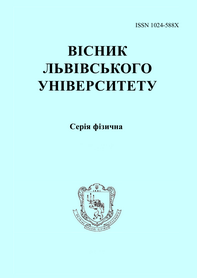DOI: https://doi.org/10.30970/vph.57.2020.65
Internal structure of stars with axial rotation
M. Vavrukh, D. Dzikovskyi

| Visnyk of the Lviv University. Series Physics
57 (2020) ñ. 65-100
DOI: https://doi.org/10.30970/vph.57.2020.65 Internal structure of stars with axial rotationM. Vavrukh, D. Dzikovskyi |  |
Axial rotation is one of the main characteristics which are inherent for both normal stars and compact objects. A new approach for calculation of internal structure of stars with rapid rotation is proposed in the frame of polytropic model with equation of state P( r)=K(\rho( r))1+1/n (where n is the polytropic index, \rho( r) is the local density, P( r) is the local pressure) and constant angular velocity \omega. The constant K and density in stellar center \rhoc=\rho(0) are also model parameters. In dimensionless form the differential equilibrium equation is two-dimensional and two-parametrical, it depends on the index n and dimensionless angular velocity \Omega=\omega(2\pi G\rhoc)-1/2. Its solutions are presented in the form of series by the orthogonal basis functions, and zero approximation is the Emden's functions, which correspond to the model with \Omega=0. Integration constants are found from the condition, that the solutions satisfy the equilibrium equation in the integral form. They are solutions of a system of linear algebraic equations in which \Omega is a parameter. At n=1 basis functions are j2l(\xi)P2l(\cos\theta), where j2l(\xi) are the spherical Bessel functions of first kind, P2l(\cos\theta) are the Legendre polynomials, \xi is the dimensionless radial coordinate, \theta is the polar angle. At n>1 basis functions are \psi2l(\xi)P2l(\cos\theta), where \psi2l(\xi) are universal functions of variable \xi, which have asymptotics of functions j2l(\xi) at \xi\ll1. They are calculated numerically. For all indices n it is established the existence of two types of solutions, which have different dependence on \Omega and describe two type of structure -- ellipsoidal and disk. Dependence of integration constants on angular velocity \Omega is calculated for indices n=1 and n=3 and established the maximal value of \Omega\rm max(n) when instability occurs. Also, polytropic characteristics (mass, polar and equatorial radii, moment of inertia) are calculated as functions of parameter \Omega. It is performed a comparison with the results of other authors obtained with the help of approximate analytical methods and numerical integration. It is proposed the algorithm for solving the inverse problem -- a determination of the model parameters K, n and \rhoc for the individual star based on known observed data -- mass, equatorial radius and eccentricity. These parameters are determined for the star \alpha Eri as well as for models, which correspond to averaged statistical characteristics of stars of early spectral classes. %